Fred Munson is the campaign director for the Cascades Conservation Partnership, an effort just being launched that aims to purchase 75,000 acres of forest to maintain and enhance a wildlife corridor between the north and central Cascade Mountains of Washington state. He just finished up a successful effort that raised $17 million to purchase and protect 25,000 acres of the Loomis State Forest in north-central Washington.
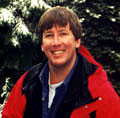
Sunday, 21 May 2000
SEATTLE, Wash.
Today turned out to be a beautiful day! I’ve just returned from a wonderful hike on the northwest flank of Mount Rainier. It wasn’t particularly hard, only a few miles each way and a 1,200-foot elevation gain, but it was gorgeous. The national park has protected its lands (unlike the surrounding private and national forest lands), so the hike was through old-growth forest the whole way to a beautiful lake in a glacial cirque.
My wife Laurie (Valeriano, for all you fans of the Washington Toxics Coalition) and our friend Monica Rhode, who works with Lois Gibbs at the Center for Environmental Health and Justice, went along for the hike. Monica is in town helping Laurie with a People’s Hearing on dioxin pollution Monday night. It’s hard to imagine when you’re hiking in virgin old-growth that there are still nasty pollution problems in the Northwest like dioxin-spewing pulp and paper mills … but I digress.
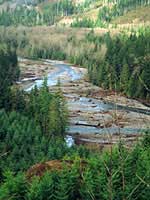
The Carbon River, north of Mount Rainier.
Photo: Charlie Raines.
While we were down in the Carbon River area of Mount Rainier, I stopped to check out some of the lands that we have proposed for acquisition. They’re just on the other side of the Carbon River from Mount Rainier National Park. They’re beautiful, but it doesn’t take but two minutes of driving west to see the fate that awaits them … clearcutting.
Ya see, I’m the campaign director for the newly formed Cascades Conservation Partnership. The partnership is an unprecedented three-year campaign to purchase and protect over 75,000 acres of privately owned forests that link the Alpine Lakes to Mount Rainier. This effort would protect most of the remaining old-growth forests left on private land in this region. Most of this old-growth is threatened with logging within the next one to three years. These old-growth forests and the habitat they provide are critical to the survival of wildlife species such as gray wolf, grizzly bear, pine marten, fisher, northern goshawk, and great gray owl. Our effort would simultaneously protect 26 miles of river, 15 lakes, and over 45 miles of hiking trails just an hour’s drive from Seattle. The campaign will raise $25 million dollars in private funds and persuade the federal government to contribute at least $100 million from the Land and Water Conservation Fund.
It was nice to have a day off, as last week was crazy and this week promises to be the same. We’re having our big launch press conference on Tuesday at REI. However, our campaign was outed last Thursday by a front-page Seattle Post-Intelligencer article by Joel Connelly. It was a good story with nice placement, and Joel did a good job of ferreting out the details of the story even though we weren’t cooperating with him. However, the early announcement has caused some serious political problems for us.
Over 60 percent of the land that we’re working to purchase and protect is in Kittitas County, on the eastern flanks of the Cascades. Those of you who are familiar with politics in the Northwest know that most of the counties on the east side of the mountains are highly conservative, generally Republican, suspicious of the federal government, tired of federal control of “their” land, and in some cases off-their-rockers worried about black helicopters and U.N. invasions. (Really! A public official in Okanogan County near the Loomis Forest swore a few years ago that he saw United Nations tanks rolling through the town of Oroville!)
Anyway, we had scheduled meetings with the county commissioners and local press for this Monday before the launch so we could at least present the proposal to them in person and in a positive light. We wanted to let them know we respected their legitimate concerns and wanted to work with them to help resolve them. Instead, because of the P-I story, they heard about our effort from local reporters asking them for comment on a plan they knew nothing about. As you can imagine, that didn’t go over well.
So, we have staff and volunteers on the way over there early Monday morning for the previously scheduled meetings to try and repair some of the political damage. Meanwhile, I’ll being making press calls and pulling together the folks speaking at our launch press conference for a practice session, getting all our materials and maps together, etc.
But I still have a few hours left of my night off, so I think it’s time to go fire up the hot tub. A little decadence goes a long way.
Monday, 22 May 2000
SEATTLE, Wash.
I started off this morning with a 7:00 a.m. live radio interview with a Portland, Ore., all-news radio station. I was just a tad nervous because it has been a few months since I have done a live interview, and this was one of my first interviews on this new campaign. After a shower and a cup of coffee, I was ready and, of course, it went fine.
After this, I was off to work to get all the materials together for our big launch press conference tomorrow. We have all the regular stuff — press release, sheet of contacts, background sheets on various aspects of the campaign, blown-up photos and maps, executive summaries of reports, etc.
One of the most interesting pieces, though, is a series of three GIS “trends” maps that have computer-modeled forest “grow-out scenarios” on them. One shows the current conditions of the forests between the Alpine Lakes Wilderness and Mt. Rainier, another shows what would happen to the forests if we fail to protect them within the next 10 years, and a third shows what they would look like in 200 years if we succeed in protecting them. The contrast is stunning. In the scenario in which we fail to protect the land, it is completely fragmented and clear-cut. In the scenario in which we succeed, you see several fully protected, old-growth wildlife corridors running north to south along the crest of the Cascades.
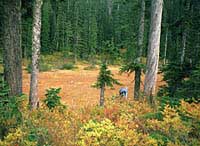
Save this corridor! Olallie Meadows, south of Snoqulmie Pass in Washington state.
Charlie Raines.
Wildlife corridors, simply defined, are connected tracts of wildlife habitat. The U.S. Forest Service’s Northwest Forest Plan recognizes the area between Mt. Rainier and the Alpine Lakes as the “critical connective link in the north-south movement of organisms in the Cascade Range.” The science on this point is indisputable. Numerous creatures, from the smallest salamander to the largest grizzly bear, need either very large undisturbed tracts of habitat, or at least traversable linkages between smaller patches. Without large connected tracts of habitat, populations become isolated and may suffer localized extinctions that can then lead to extirpation from larger areas. This steady loss of subpopulations, and its resulting decline in genetic diversity, is a common cause of eventual extinction of entire species.
Another way of explaining this is to think of our protected wilder
ness areas and national parks as “islands.” While numerous creatures survive today on these islands, their ultimate future survival depends on our ability to link those islands so the populations can mix and maintain their genetic diversity. Aldo Leopold knew over 50 years ago that islands of protection provided by our national parks would be insufficient to maintain healthy populations of most species. However, it’s only been in the last decade that the environmental movement has gotten serious about providing these wildlife corridors. This is what our campaign is all about.
As the day progressed, we got a couple of good pieces of news. The trip to brief the chairman of the county commissioners in Kittitas County in eastern Washington went well, with him eventually agreeing that “he could support a project like this” or something to that effect. This is progress compared to the serious concerns he expressed in the local paper on Friday. We also got a strong statement of support from U.S. Sen. Patty Murray (D-Wash.), as well as qualified support from U.S. Sen. Slade Gorton (R-Wash.).
I ended the day with a practice session for our press conference launch tomorrow at REI. We’ll be lucky if any press show since it has already been covered in both major Seattle papers, with another Seattle Times article due tomorrow morning. King 5 TV environmental reporter Scott Miller also did a long piece on the campaign tonight, which I haven’t seen yet. (I have the TV on in the other room as I write this, hoping to catch it as a repeat on NW Cable News.) Well, enough for tonight, I’ll catch ya tomorrow.
Tuesday, 23 May 2000
SEATTLE, Wash.
Wow — why am I so tired?! It was only a press conference. I’ve done at least a hundred of them between 12 years of campaigning for Greenpeace, a few years at Northwest Ecosystem Alliance doing the Loomis campaign, and now the Partnership. The thing is that everything I’ve been doing and coordinating for the past three months has been leading up to this launch. When you’re launching the largest land-acquisition campaign the Pacific Northwest has ever seen, you really want everything to be perfect. I guess I let the stress build up a bit, and now it’s time for the big release.
My wife Laurie is in the same boat. She’s exhausted as well from pulling together her People’s Hearing on Dioxin. They had over 200 folks show up last night, pretty great … but I digress.
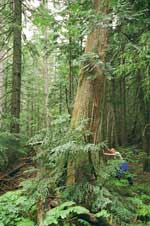
Big, huggable old-growth trees at Sawmill Creek.
Jasmine Minbashin.
So our launch press conference went great. Even though we had already been covered twice in the Seattle Times (today’s article was GREAT), on the front page of the Seattle Post-Intelligencer, on King 5 TV, and on local NPR radio, we still had two NPR stations, the local AM all-news radio show, USA Today, the P-I, and the Seattle Weekly come to the event. Not bad considering we weren’t sure we’d get anyone.
While all but one of the presentations at the press conference were flawless, the real highlight was Edith Roosevelt Derby Williams, the 80-plus-year-old granddaughter of Theodore Roosevelt. She gave a rousing conservation speech that actually got applause, something you rarely see at a press conference.
What a lift! It’s a shame how the well-worn adage is unfortunately true in my case — I’ve been working so hard at protecting the lands that I rarely get a chance to go out and enjoy them. And we have some amazing old-growth forests here, some of them in the very lands we’re trying to protect.

Forest in the Manastash Roadless Area in eastern Washington.
Charlie Raines.
The diverse forests of the central Cascades of Washington include wet westside forests with Douglas firs up to 800 years old. To the east, over the crest of the Cascades where the rains rarely make it, the forest changes to dry, open, park-like settings with large ponderosa pines. The lands include alpine meadows and steep slopes. Herds of elk and deer migrate across these lands, while hawks and eagles roost in gray snags. Salamanders slither through the damp undersides of rotting logs and the vegetation along streams. As many as 1,000 species of plants and animals are considered dependent upon or associated with the ancient forests like those found in our project area.
I vowed today that I will make time to get out into these forests this summer, and I will make sure my colleague Heidi takes the time to do so as well. The other important thing is to make time to hang with my wife, which I’m going to go do right now … More tomorrow.
Wednesday, 24 May 2000
SEATTLE, Wash.
My day started off once again with a live radio interview. Luckily, after being so tired last night, I was full of spunk this morning (plus the interview wasn’t until 8:30!), so it went well. I also found cool stories about our project on the websites of the two local NPR stations — you can listen to them at KPLU and KUOW.
We also got a cool mention today in the Seattle Times (third one) in a column entitled “Fired Up with ‘Estro’ Activism” that honored, among other people, the wonderful woman I told you about yesterday, Edith Roosevelt Derby Williams, the granddaughter of Theodore Roosevelt.
The rest of my day was spent trying to catch up with a million details and get back on track with the other plans we have laid to actually accomplish the goal we have now so successfully told the public we are going to accomplish. These included more planning for eastside political and editorial board meetings; working on figuring out why our website connection doesn’t work for some folks (feel free to try it yourself — www.cascadespartners.org — but it’s been having problems all day); making arrangements to brief various high donor prospects, including some that we are going to fly over the proposed conservation areas (courtesy of LightHawk) and also take on hiking trips, etc., etc.
One really great piece of news came by a voicemail message today. A friend and large contributor to the Loomis Forest Fund left a message saying he and his wife were definitely interested in a significant donation to this project! Previously he was skeptical of our ability to line up the necessary political support to make it real. This is great news, as he is a great guy and we were really hoping he would support us in this effort.
While this may not flow all that well from where I’m at in this diary entry, I’d like to take this chance to let folks know why we are concentrating on this particular area of the Cascades, and also how the area got so chopped up. So, here goes …

Washington’s Yakima River.
Photo: Charlie Raines.
The area of the Cascade Mountains closest to Seattle happens to be where public ownership and protection of wildlife habitat is mos
t limited. It comprises the narrowest expanse of public protected land in the entire Cascade Range from Northern California to southern British Columbia. Picture the public lands of Washington’s Cascades looking like an hourglass with the much-loved Alpine Lakes Wilderness, North Cascades National Park, and other wildlands to the north, and Mt. Rainier National Park and adjacent public lands to the south. The area around Snoqualmie Pass is the narrow portion, or bottleneck. This area is a critical migration corridor for many species native to these forests.
Forestlands of this bottleneck are further compromised by intermittent clearcuts in a checkerboard of mixed private and public ownership, resulting from an 1864 decision made by the Congress (and honest Abe Lincoln) to grant land to railroads for expansion to the west. They were given alternating sections (one mile square) for 40 to 50 miles on both sides of the railroad right-of-way for each mile of track laid. Since the railroad ran right through Stampede Pass, hundreds of thousands of acres in the Cascades bottleneck region were “checkerboarded.” More than a century later, the human population is booming in the region and our natural heritage is threatened. As land managers seek to protect habitat for diverse species, they are constantly challenged by the checkerboard of clearcut private timberlands and forested public lands in this area.
Recent efforts by conservation groups in Washington have resulted in the consolidation and conservation of some of these lands through advocating for land exchanges (including the I-90 land exchange) between private timber companies and the U.S. Forest Service. But there is much more private land left to conserve and no public land left (that anyone is willing to part with anyway) to trade for it. So, the option we’re left with is buying it. It doesn’t always make me happy, paying timber companies for land that should really have been the public’s in the first place (except for that huge giveaway in 1864), but the bottom line is, if we want to be effective and actually solve the problem, this is the only avenue left.
Until tomorrow…
Thursday, 25 May 2000
SEATTLE, Wash.
I went home last night and had a wonderful meal, with fresh broccoli rob (Italian broccoli) from the garden. Laurie and I turned off the TV (we watch way too much TV) and just read for a while (before she got her backrub). I’ve had a subscription for years to The Sun, a wonderful magazine without any advertisements, with stories about the trials and tribulations of life. The great thing is that, for the most part, they’re not activist-oriented pieces about issues, but more like real-life testimonials and stories. In fact, my favorite section is “Readers Write.” There is a different topic for each month and readers write in letters about whatever the topic stirs in them. It’s fascinating to read different people’s stories about the very same topic and be reminded of the breadth of experiences there are out there in the world. I highly recommend this magazine, folks. It’s occasionally depressing, but often so insightful, uplifting, or funny that I just scream.
Unfortunately, my morning was not so nice as the night before. We were awakened at 5:00 a.m. by the third and final “aerial assault” from our lovely Washington Department of Agriculture. They found one Asian gypsy moth in my Ballard neighborhood in Seattle last year and decided that was an infestation that could only be treated by spraying the pesticide Foray 48 from a helicopter three times over a heavily populated section of the city. While no one wants the Asian gypsy moth to become established here, there is in fact no evidence that it actually could.
Worse yet, they want to spray this very same pesticide (for which they won’t release the list of “inert” ingredients) over 600,000 acres of national forest in Washington state to control the Tussock moth, a naturally occurring insect in this region. It is amazing that this 1950s mentality is still alive and well in the 21st century.
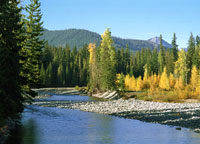
Inspiration for uninspiring tasks: The Cle Elum River.
Photo: Charlie Raines.
The rest of my day was filled with tasks that don’t inspire me to write, although they were important. We had a staff meeting, worked on details of how we will keep track of campaign donors in a database, discussed how we’re going to set up our grassroots campaign, made a thousand photocopies, and other similar tasks. Just not exciting stuff. I have noticed over the years that much of activism, like any other job, consists of a thousand mundane tasks strung together in such a way as to have a huge impact. Yet, while in the middle of those tasks, they can seem very uninspiring.
I’ve had my dream job for the last 15 years of my life. Yet it is easy to occasionally forget that it is my dream job. As James Thurber said, “I suppose that even the most pleasurable of imaginable occupations, that of batting baseballs through the windows of the RCA Building, would pall a little as the days ran on.” It’s good to remember why we do what we do, so I think I’ll end this diary series with two more quotes that sum up for me why I do what I do.
Don’t you know that if people could bottle the air they would? Don’t you know there would be an American Air Bottling Association (AABA)? And don’t you know that they would allow thousands and millions to die for want of breath if they could not pay for air?
— Robert IngersollTo give up the task of reforming society is to give up one’s responsibility as a free man.
— Alan Paton


